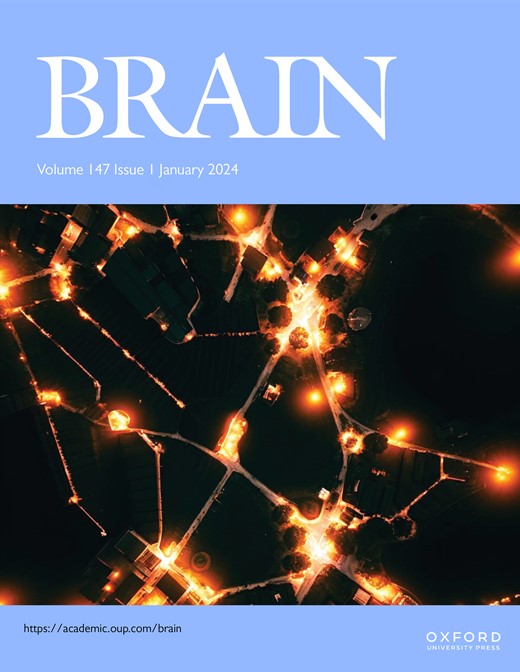Preclinical and first-in-human evidence of 4-hydroxybenzoic acid for mitochondrial COQ2 deficiency.
IF 11.7
1区 医学
Q1 CLINICAL NEUROLOGY
引用次数: 0
Abstract
Primary coenzyme Q (CoQ) deficiency is a mitochondrial disorder with variable clinical presentation and limited response to standard CoQ10 supplementation. Recent studies suggest that 4-hydroxybenzoic acid (4-HBA), a biosynthetic precursor of CoQ, may serve as a substrate enhancement treatment in cases caused by pathogenic variants in COQ2, a gene encoding a key enzyme in CoQ biosynthesis. However, it remains unclear whether 4-HBA is required throughout life to maintain health, whether it offers advantages over CoQ10 treatment, and whether these findings are translatable to humans. Here, we demonstrate that lifelong 4-HBA supplementation in a murine model carrying the pathogenic Coq2A252V variant is well tolerated and prevents the onset of mitochondrial encephalopathy. In contrast, withdrawal of 4-HBA leads to progressive neurological decline. Notably, while conventional CoQ10 supplementation transiently ameliorated cardiac dysfunction, it failed to prevent fatal neurological deterioration. Guided by these preclinical findings, we initiated a first-in-human individual therapeutic trial with 4-HBA in a 3-year-old boy with genetically confirmed primary CoQ10 deficiency due to compound heterozygous pathogenic COQ2 variants. The patient presented with a Leigh-like syndrome characterized by bilateral brain lesions, developmental delay, muscular hypotonia, failure to thrive, lactic acidosis, and steroid-resistant nephrotic syndrome. Despite high-dose oral CoQ10 supplementation, clinical response had been minimal. Prior to clinical application, patient-derived fibroblasts were treated in vitro with 4-HBA, resulting in a marked increase in endogenous CoQ10 levels. Following the initiation of oral 4-HBA treatment, the patient experienced rapid and sustained remission of proteinuria, improved renal hyperfiltration, and a gradual increase in serum CoQ10 concentrations. No adverse effects were observed during a six-month follow-up. Clinically, the patient showed notable improvements in motor skills, language acquisition, cognitive alertness, and overall development, accompanied by significant gains in growth and nutritional status. Clinical recovery was also reflected by improved scores on the Newcastle Paediatric Mitochondrial Disease Scale. These findings support 4-HBA as a promising targeted metabolic treatment for COQ2-related CoQ deficiency and highlight the need for further clinical investigation.4-羟基苯甲酸治疗线粒体COQ2缺乏的临床前和首次人体证据。
初级辅酶Q (CoQ)缺乏症是一种线粒体疾病,具有不同的临床表现,对标准辅酶q10补充的反应有限。最近的研究表明,CoQ的生物合成前体4-羟基苯甲酸(4-HBA)可能在COQ2致病变异引起的病例中作为底物增强治疗,COQ2是编码CoQ生物合成关键酶的基因。然而,目前尚不清楚4-HBA是否需要在整个生命过程中维持健康,它是否比辅酶q10治疗更有优势,以及这些发现是否适用于人类。在这里,我们证明了在携带致病性Coq2A252V变异的小鼠模型中终生补充4-HBA具有良好的耐受性,并且可以防止线粒体脑病的发生。相反,停用4-HBA会导致进行性神经功能衰退。值得注意的是,虽然传统的辅酶q10补充剂可以短暂地改善心功能障碍,但它不能防止致命的神经系统恶化。在这些临床前研究结果的指导下,我们在一名3岁男孩中启动了一项首次使用4-HBA的人体个体治疗试验,该男孩因复合杂合致病性COQ2变异而遗传上证实原发性CoQ10缺乏。患者表现为leigh样综合征,其特征为双侧脑损伤、发育迟缓、肌肉张力下降、发育不全、乳酸酸中毒和类固醇抵抗性肾病综合征。尽管大剂量口服辅酶q10,临床反应很小。在临床应用之前,用4-HBA体外处理患者源性成纤维细胞,导致内源性CoQ10水平显著升高。在开始口服4-HBA治疗后,患者经历了快速和持续的蛋白尿缓解,肾脏高滤过改善,血清CoQ10浓度逐渐增加。在六个月的随访中未观察到不良反应。在临床上,患者在运动技能、语言习得、认知警觉性和整体发育方面均有显著改善,同时在生长和营养状况方面也有显著改善。临床恢复也反映在纽卡斯尔儿科线粒体疾病量表得分的提高上。这些发现支持4-HBA作为一种有希望的coq2相关CoQ缺乏症的靶向代谢治疗方法,并强调需要进一步的临床研究。
本文章由计算机程序翻译,如有差异,请以英文原文为准。
求助全文
约1分钟内获得全文
求助全文
来源期刊

Brain
医学-临床神经学
CiteScore
20.30
自引率
4.10%
发文量
458
审稿时长
3-6 weeks
期刊介绍:
Brain, a journal focused on clinical neurology and translational neuroscience, has been publishing landmark papers since 1878. The journal aims to expand its scope by including studies that shed light on disease mechanisms and conducting innovative clinical trials for brain disorders. With a wide range of topics covered, the Editorial Board represents the international readership and diverse coverage of the journal. Accepted articles are promptly posted online, typically within a few weeks of acceptance. As of 2022, Brain holds an impressive impact factor of 14.5, according to the Journal Citation Reports.
 求助内容:
求助内容: 应助结果提醒方式:
应助结果提醒方式:


